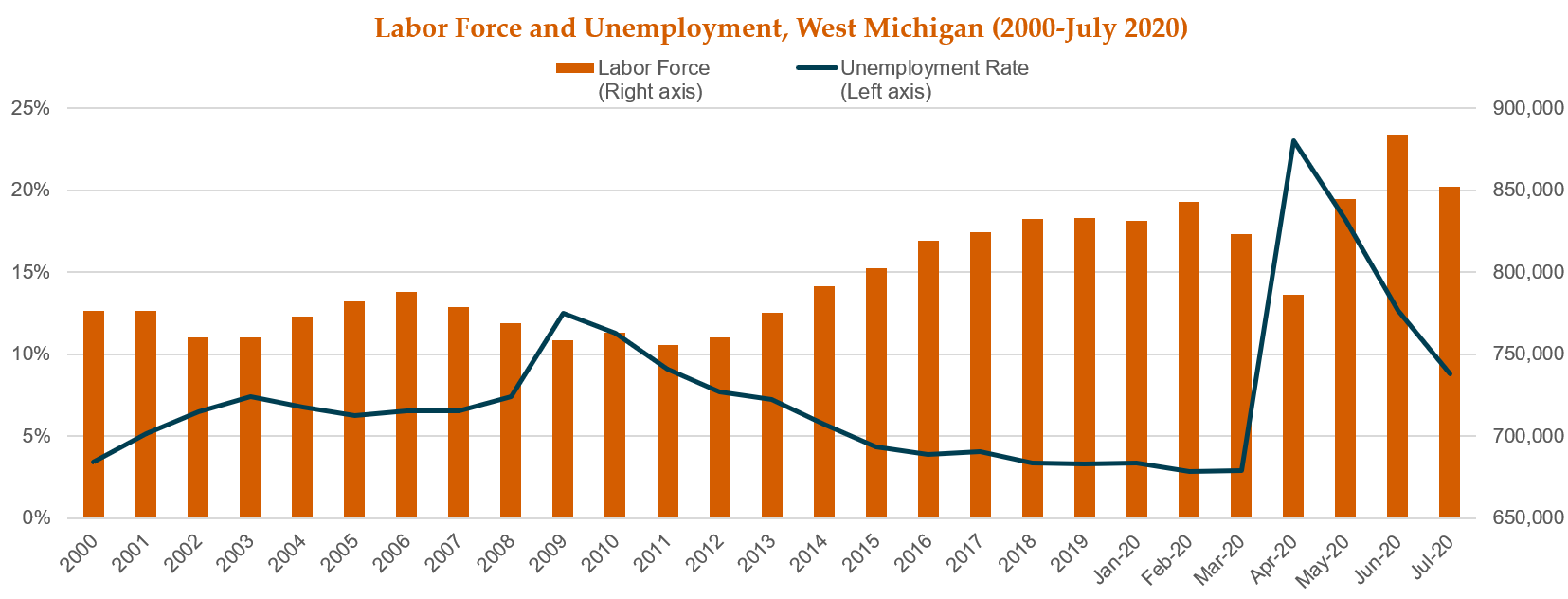Labor Market Trends across Michigan
The unemployment rate across the state reached historic levels at the onset of the pandemic, skyrocketing to achieve a rate of 23.6 percent in April — the highest jobless rate seen for the state since at least 1976 (as far back as comparable records extend) — and stood at 8.7 percent as recently as July. The 6.2 percentage point recovery to the state’s unemployment rate occurring from June to July reflects an increase of 193,000 to the number of employed residents across Michigan, which still remains nearly 372,000 below employment counts recorded in February. The number of unemployed residents in Michigan fell by 320,000 over-the-month, which was the largest monthly decrease observed since the onset of the pandemic. Although the size of the unemployed population in Michigan remains over 130 percent larger than counts from February, it is a far cry from the record-high of 1.1 million unemployed observed in April at the onset of the pandemic.
Stagnating Recovery in West Michigan
The 23.0 percent rate of unemployment seen for West Michigan in April was a historic high — reflecting a spike of 20.1 percentage points from the rate of 2.9 percent recorded in March — though the region’s jobless rate has since recovered to stand at 8.8 percent as recently as July. The modest economic recovery observed in West Michigan over-the-month resulted from an employment gain of 4,917 (+0.6%), while the number unemployed dropped by 37,062 (-33.1%) from June to July to achieve a total of 74,811 — which remains over 3 times larger than unemployment counts recorded in February. Despite these seemingly positive labor market signals, however, the region’s labor force lost over 32,000 participants (reversing the trend of continued labor force growth observed from April to June) and employment counts only improved by 4,917 over-the-month, indicating that West Michigan’s shrinking unemployment counts observed in July resulted predominately from labor force separations, rather than jobseekers finding full-time employment.

Source: DTMB, Bureau of Labor Market Information and Strategic Initiatives, Local Area Unemployment Statistics
As indicated by recent Gallup polling, it would appear that jobseeker optimism has plummeted since the pandemic with 77 percent of respondents reporting that it’s a ‘bad time to find a quality job’ and 8 percent of Americans now considering relocation as a result of the pandemic — which might suggest that a growing number of West Michigan jobseekers are delaying their job searches until the economy stabilizes. According to polling from The Economist/YouGov, these discouraged jobseekers most likely identify as millennials, women, Hispanic/Latino, or Black/African American — with each subpopulation experiencing a disproportionate uptick in unemployment, labor force separations, and financial hardships when compared to their peers as a result of the pandemic.

Source: U.S Census Bureau, Current Employment Statistics (CES)
West Michigan’s job count rose by 2,700 from June to July, signaling the third month of positive job growth for the region since the pandemic-imposed state lockdown in March. However, the over-the-month growth rate of 0.5 percent pales in comparison to the rate of 8.5 percent observed from May to June — suggesting that job growth in West Michigan is beginning to stagnant as a majority of furloughed workers have since returned to work. Job recovery over-the-month was most pronounced among Goods-producing industries, which gained 1,200 jobs (+0.8%), while Service-providing industries gained 1,500 jobs (+0.4%). The largest over-the-month job gains were concentrated among Leisure and Hospitality (+11.3%; +4,600 jobs), Accommodation and Food Services (+8.9%; +3,200 jobs), Other Services (+7.0%; +1,500 jobs), and Professional and Business Services (+1.0%; +1,100 jobs). Conversely, five sectors in West Michigan experienced job loss into July, including Government (-6.3%; -3,200 jobs), Education and Health Services (-1.8%; -1,700 jobs), Information (-1.6%; -100 jobs), Retail Trade (-1.4%, -800 jobs), and Trade, Transportation and Utilities (-0.6%; -600 jobs).

Source: U.S Census Bureau, Current Employment Statistics (CES)
Although nearly all West Michigan industries have shown evidence of recovery since March, total regional job counts are still 58,200 (-9.3%) short in comparison to the counts recorded before the pandemic, with significant variations across industries and sectors. Goods-producing industries have lost roughly 10,600 jobs since the onset of the pandemic, a growth rate of -6.7 percent, while Service-providing industries have lost over 47,000 workers (-10.2%). Pandemic-related job losses were especially pronounced among Accommodation and Food Services — which has lost over 20 percent of its workforce since March (-10,200 jobs) — and Leisure and Hospitality, which lost 9,800 jobs (-17.8%). As of June, Mining, Logging, and Construction remained the only industry in West Michigan to employ more workers following the lockdown than before it, gaining 3,900 jobs (+14.0%) since March.
Subscribe to receive blog updates
{{cta(‘be643ac7-73e2-40f6-a7b2-7c5927924bf4’)}}


